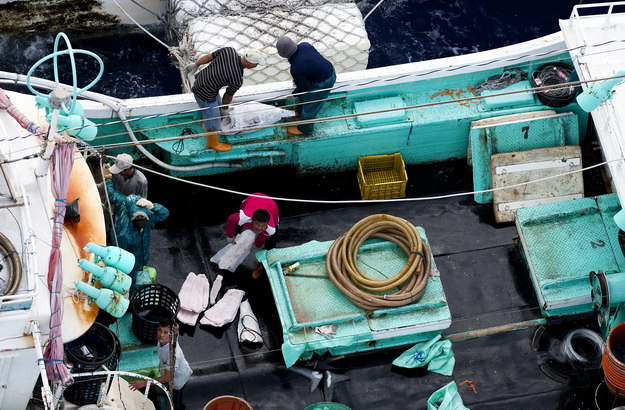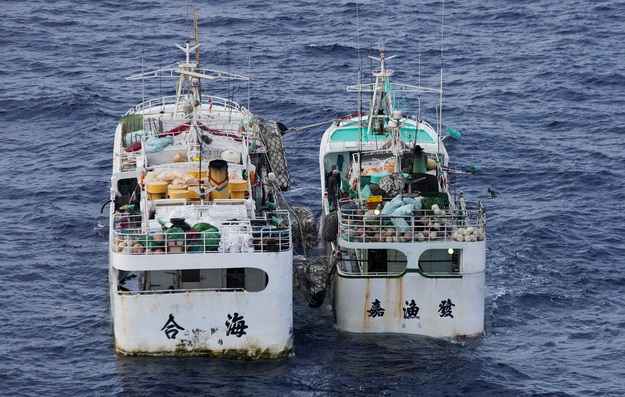國際環保組織綠色和平與台灣動物社會研究會21日召開記者會,指出台灣政府近年宣示要推動永續漁業發展,但實際作為卻是「說一套做一套」。在兩組織公佈的「台灣在太平洋鮪漁業的角色:確保永續漁業」簡報中,要求台灣政府正視漁業監管不足的情況,並呼籲台灣作為「中西太平洋漁業委員會」(WCPFC)的會員,應支持今年12月在大溪地的年會中提議關閉太平洋四個公海區域,成立海洋保育區的方案,以積極行動保障台灣鮪漁業的永續發展。
綠色和平船艦「希望號」(The Esperanza)在今年8月23日至10月19日在太平洋海域巡邏,監督區域內漁船捕撈活動。期間於9月2日發現台灣籍小型延繩釣船「嘉漁發」號在密克羅尼西雅聯邦 (FSM) 的公海上將漁獲轉運至同為台灣籍的「合海」號上。綠色和平隨即查證,「嘉漁發」號雖持有FSM海域的捕魚許可,但條款卻禁止在海上轉運漁獲;「合海」號則未獲得任何太平洋島國的捕魚許可。由於「嘉漁發」號並未獲得海上魚貨轉運的許可,行為已明顯違法。綠色和平將有關的調查報告交與中西太平洋漁業委員會,以及台灣漁業署,要求他們正視台灣漁船的違法行為。
 |
 |
|
綠色和平組織在今年9月2日發現台灣漁船的非法轉運魚貨行為。(照片版權:GREENPEACE)
|
|
綠色和平今年在太平洋行動的2個多月期間,就在海上紀錄了13艘來自菲律賓、台灣、日本、韓國、美國、巴拿馬漁船的行為。當中就有7艘是台灣籍漁船或由台灣公司經營,並證實其中3艘有非法行為;另外4艘則沒有任何太平洋島國的捕魚許可,卻長年在鮪魚重要的繁殖及護養區域內進行撈捕作業,可見台灣漁船對太平洋鮪魚生態造成的衝擊。
綠色和平海洋項目主任Sari Tolvanen表示:「發現台灣漁船的非法行為只是冰山一角,我們認為台灣政府至今仍無法有效管理漁船。如果繼續漠視漁業的管理,任由過度捕撈及違法的情況發生,中西太平洋就會面臨漁業資源嚴重枯竭的問題,台灣的鮪漁業也會隨之崩潰。」
動物社會研究會執行長朱增宏則指出,台灣政府口口聲聲要保障遠洋漁業的永續,但對於國際保育組織訴求關閉太平洋四個公海區域,讓魚群生態得以休養生息的呼籲,卻一直抱持觀望態度。台灣雖已開始限縮遠洋漁業船隊的發展,但目前鰹鮪漁業總作業大、小漁船數仍有2,500餘艘(註)之多,台灣政府及產業必須積極回應保育鮪魚資源的行動方案,支持國際呼籲減漁及設立海洋保育區的行動。
兩組織在11月21日至29日,於台北誠品書店敦南店地下二樓,舉行「福爾摩莎的鮪網-再見.太平洋?」的展覽,以深刻攝人的影像,向公眾展示太平洋鮪魚面臨的危機,及台灣漁業所扮演的角色。更有互動形式讓公眾一同表達關注太平洋鮪魚保育的聲音。詳細資訊可上網查詢http://blog.yam.com/pacifictuna。
表一:綠色和平保衛太平洋行動2009 (2009/08/23~10/19)
|
日期 |
地點 |
船名(船籍) |
註解 |
|
2009/09/02 |
1號袋狀公海 |
嘉漁發(台灣) |
非法漁獲轉運 |
|
2009/09/02 |
1號袋狀公海 |
合海(台灣) |
非法漁獲轉運 |
|
2009/09/11 |
2號袋狀公海 |
福一丸85號(日本) |
在為期兩個月的禁令期間,使用人工集魚裝置進行漁撈 |
|
2009/09/14-15 |
2號袋狀公海 |
Oryong 717(韓國) |
擁有所羅門群島及吉爾伯特漁業許可牌照,卻在公海捕漁 |
|
2009/09/17 |
2號袋狀公海 |
American Legacy(美國) |
08年在台灣製造 |
|
2009/09/17 |
2號袋狀公海 |
豐祥888 (巴拿馬) |
向圍網漁船「American Legacy」補給燃料 |
|
2009/09/18 |
2號袋狀公海 |
Chung Yong 73(韓國) |
擁有吉爾伯特水域漁業許可牌照,卻在公海捕漁 |
|
2009/10/07 |
庫克群島專屬經濟區 |
Koyu Maru 3(日本) |
擁有吉爾伯特水域漁業許可牌照,卻在庫克群島的專屬濟區內非法捕漁,由一家台灣企業所持有 |
|
2009/10/14-15 |
3號袋狀公海 |
Kai Jie No.1(台灣) |
並無任何太平洋島國發出的漁業許可牌照,只在公海捕漁 |
|
2009/10/15 |
3號袋狀公海 |
Chu Huai No.368(台灣) |
並無任何太平洋島國發出的漁業許可牌照,只在公海捕漁 |
|
2009/10/16 |
3號袋狀公海 |
Ming Jyh Fwu No.16(台灣) |
06年新建的漁船,並無任何太平洋島國發出的漁業許可牌照,只在公海捕漁 |
|
2009/10/16 |
3號袋狀公海 |
玉龍發 36(台灣) |
06年新建的漁船,並無任何太平洋島國發出的漁業許可牌照,只在公海捕漁 |
註:台灣漁業署漁業統計年報2007年
Taiwanese government continues to riskthesustainability of its own fishing industry
Environmentalgroups call for Taiwan to support marine reserves
Taipei, 21 November 2009. Greenpeace and the Environment and Animal Society of Taiwan (EAST) released a new report[1] today, illustrating that illegal and overfishing by the Taiwanese controlled fishing fleets continue to plunder vulnerable Pacific high seas and are putting the industry itself and its long term survival at risk as tuna stocks decline.
The report includes evidence of Taiwanese fishing vessels caught in illegal acts during a recent Greenpeace expedition in the Pacific Ocean and highlights that despite recent new legislative measures in Taiwan, the government is still unable to effectively control its distant water fishing fleets and nationals involved in fishing under other flags. In order to ensure sustainable fisheries the Government needs to support international conservation measures and proposals of Pacific Island Countries to close four areas of international waters[2] in the Pacific Ocean to all fishing activities at the upcoming annual meeting of the Western and Central Pacific Fisheries Commission (WCPFC) in Tahiti December 7-11th.
The Greenpeace ship Esperanza recently completed an eight-week Defending Our Pacific expedition[3] during which it documented 13 vessels from Philippines, Taiwan, Japan, Korea, US and Panama. Seven of the vessels carried Taiwanese flags or were found to be operated by Taiwanese companies, from which three were caught fishing or transferring fish illegally while the other four were fishing exclusively in the vulnerable high seas pockets where surveillance is non-existent. Greenpeace presented an investigation report of the illegal incidents to both the WCPFC and Taiwan’s Fisheries Agency and demands that the Taiwanese government take immediate action to control the activities of Taiwanese fishing operations internationally.
“This recent example of Taiwanese small-scale longliners engaging in illegal acts is just the tip of the iceberg. Dozens of reports are released from around the world every year to tell the story of Taiwan’s fishing fleets out of control,” said Greenpeace Oceans Campaigner Sari Tolvanen. “This cannot continue as the sustainability of the tuna stocks and the fishing industry itself is under threat. Unless urgent and immediate action is taken, the fishing industry will simply fish itself and our oceans to death.”
EAST’s Executive Director Wu Hung singled out his criticism for the Taiwanese government for vowing to protect the sustainability of distant water fisheries while in practice is reluctant to support the closure of the four high seas pockets in the Pacific.
“It is time that the Taiwanese fishing industry and government look into the science and respond to its call. Tuna catch must be cut by half and setting up of marine reserves needs to be supported as essential mechanism in ensuring protection of our oceans.” stated Wu. Although Taiwan has
reduced its distant water fishing vessels in recent times, the remaining fleet capacity at 2500[4] vessels still far exceeds economically viable and sustainable catches of tuna.
The two groups will be holding an exhibition in Taipei from November 21st to 29th, 2009 to present captivating photographs of the current oceans crisis and the plight of Pacific tuna. The public can participate via interactive activities at the exhibition.
Formosa & Tuna – Netting up the Pacific Exhibition
Venue: Eslite Book Store, Dun-Nan Branch, Taipei
Date: November 21st-29th
ENDS
Table 1 Greenpeace Definding Our Pacific Expedition 2009 (23/08~19/10/2009)
|
Date |
Location |
Name of Ship (Flag) |
(Remarks) |
|
02/09/2009 |
High Seas Pocket 1 |
Ja Yu Fa(Taiwan) |
Illegal transshipment |
|
02/09/2009 |
High Seas Pocket 1 |
Her Hae(Taiwan) |
Illegal transshipment |
|
11/09/2009 |
High Seas Pocket 2 |
Fukuichi Maru No.85(Japan) |
Continued use of FAD during the two-month FAD ban period. |
|
14-15/09/2009 |
High Seas Pocket 2 |
Oryong 717(Korea) |
Holding fishing license from the Solomon Islands or Kiribati but fishing at high seas. |
|
17/09/2009 |
High Seas Pocket 2 |
American Legacy(U.S.A) |
Made in Taiwan in 2008. |
|
17/09/2009 |
High Seas Pocket 2 |
Fong Seong 888(Panama) |
Refueling the purse seiner the American Legacy at sea. |
|
18/09/2009 |
High Seas Pocket 2 |
Chung Yong 73(Korea) |
Holding fishing license from Kiribati but fishing at high seas. |
|
07/10/2009 |
Cook Islands EEZ |
Koyu Maru 3(Japan) |
Holding fishing license from Kiribati but fishing in Cook Islands’ water. Owned by a Taiwanese enterprise. |
|
14-15/10/2009 |
High Seas Pocket 3 |
Kai Jie No.1(Taiwan) |
Does not hold any fishing license from the Pacific Island countries. Can only fish at high seas. |
|
15/09/2009 |
High Seas Pocket 3 |
Chu Huai No.368(Taiwan) |
Does not hold any fishing license from the Pacific Island countries. Can only fish at high seas. |
|
16/10/2009 |
High Seas Pocket 3 |
Ming Jyh Fwu No.16(Taiwan) |
Does not hold any fishing license from the Pacific Island countries. Can only fish at high seas. Built in 2006. |
|
16/10/2009 |
High Seas Pocket 3 |
Yu Long Fa No. 36(Taiwan) |
Does not hold any fishing license from the Pacific Island countries. Can only fish at high seas. Built in 2006. |
[1] http://www.greenpeace.org/australia/resources/reports/overfishing/taiwan-s-role-in-pacific-tuna
[2] http://www.greenpeace.org/international/campaigns/oceans/marine-reserves/pacific-tuna-need-marine-reserves
[3] www.greenpeace.org/defending-our-pacific2009-summaryreport
[4] 2007 Taiwan Fisheries Agency Annual Statistics Report








